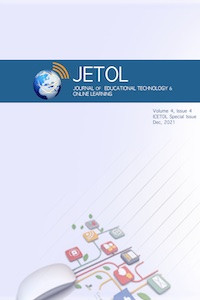Öz
Kaynakça
- Referans1 Ajjawi, R., and D. Boud. 2018. “Examining the Nature and Effects of Feedback Dialogue.” Assessment and Evaluation in Higher Education. doi:10.1080/02602938.2018.1434128.
- Referans2 Anson, C. M., D. P. Dannels, J. I. Laboy, and L. Carneiro. (2016). “Students’ Perceptions of Oral Screencast Responses to Their Writing: Exploring Digitally Mediated Identities.” Journal of Business and Technical Communication 30 (3): 378–411.
- Referans3 Boud, D., and E. Molloy.(2013). “Rethinking Models of Feedback for Learning: The Challenge of Design.” Assessment and Evaluation in Higher Education 38 (6): 698–712.
Öz
QR Codes have been flourishing the education for many long with the variety of activities in use it provides, and have been preferred especially for being simple and quick in education. Feedback is another significant element for learners since it guides the learners for qualified essays. The aim of this qualitative study is to find out the experiences of preservice English teachers on video feedback via QR codes. 50 preservice teachers were asked to write two essays. At the end of the term, data were collected via an open-ended questionnaire and semi-structured interviews. 23 of the candidates completed the open-ended questionnaire and 8 of them accepted to be interviewed. Data were analyzed through thematic coding. It was expected that the participants would develop positive attitudes towards video feedback, yet the findings showed they prefer written feedback on their word files and felt safer that way. This study may contribute to the field in terms of how to develop ways to provide more efficient feedback for preservice teachers and may show that affective factors have also key roles in the success of certain methods and approaches in teaching.
Anahtar Kelimeler
video feedback preservice ELT teachers academic writing online learning
Kaynakça
- Referans1 Ajjawi, R., and D. Boud. 2018. “Examining the Nature and Effects of Feedback Dialogue.” Assessment and Evaluation in Higher Education. doi:10.1080/02602938.2018.1434128.
- Referans2 Anson, C. M., D. P. Dannels, J. I. Laboy, and L. Carneiro. (2016). “Students’ Perceptions of Oral Screencast Responses to Their Writing: Exploring Digitally Mediated Identities.” Journal of Business and Technical Communication 30 (3): 378–411.
- Referans3 Boud, D., and E. Molloy.(2013). “Rethinking Models of Feedback for Learning: The Challenge of Design.” Assessment and Evaluation in Higher Education 38 (6): 698–712.
Ayrıntılar
| Birincil Dil | İngilizce |
|---|---|
| Konular | Eğitim Üzerine Çalışmalar |
| Bölüm | Makaleler |
| Yazarlar | |
| Yayımlanma Tarihi | 31 Aralık 2021 |
| Yayımlandığı Sayı | Yıl 2021 Cilt: 4 Sayı: 4 - ICETOL Special Issue |


